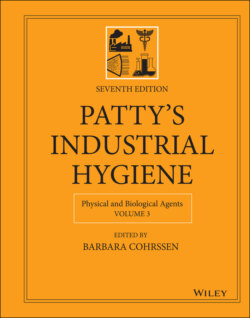Читать книгу Patty's Industrial Hygiene, Physical and Biological Agents - Группа авторов - Страница 37
7.1.3 Derived Radiation Safety Standards
ОглавлениеThe primary annual dose limits include the sum of external doses and doses due to radionuclides within or on the surface of the body. To achieve the primary standard, secondary standards are prescribed, which establish an annual limit of intake (ALI) for all radionuclides in air and in potable water. The ALI is the maximum intake of radionuclide, either by inhalation or by ingestion, which results in the primary annual dose limit to the worker if radiation exposure were limited to that radionuclide taken in through that portal of entry. Thus, the ALI must be proportionally decreased if a worker is exposed to more than one radionuclide and/or external radiation.
Tertiary limits are expressed as radionuclide concentrations in air and in water. In the case of occupational exposure to airborne radioactivity, the derived air concentration (DAC) is the inhalation ALI divided by the volume of air, 2400 m3, that the worker is assumed (according to the Reference Man model) to inhale during the course of a working year. Effluent limits to the air and to the water environments are derived in a similar manner using the dose limit for the public rather than the occupational dose limit.
These standards are enforced through a system of licensing, inspection, and fines for violations. The NRC is authorized to delegate its licensing and inspection of by‐product material to Agreement States. An Agreement State is a state that has signed an agreement with the NRC to regulate the use of radioactive materials within that state to at least the same degree as the NRC. The state must show the NRC that it has the resources to meet this obligation. The agreement may be terminated if the state does not meet the NRC's criteria. At this time, 2018, there are 38 Agreement States.
The NRC regulates some, but not all, naturally occurring radioactive materials that have been concentrated (226Ra) and all radionuclides produced in accelerators based on changes in the Atomic Energy Act in 2005. The NRC does not regulate the manufacture or use of radiation‐producing machines, such as X‐ray machines and particle accelerators.
The NRC's regulations are published in Title 10, Code of Federal Regulations. To assist applicants for NRC licenses, or to assist licensees in complying with the regulations, the NRC publishes Regulatory Guides and NUREG documents. These guides describe procedures and methods that are acceptable to the NRC for the purpose of demonstrating compliance with the regulations.
